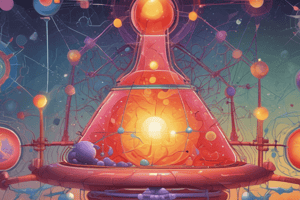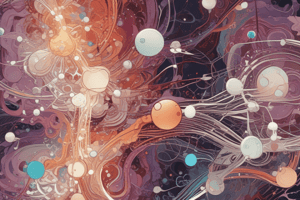Podcast
Questions and Answers
Which state of matter is characterized by having a definite volume but no definite shape?
Which state of matter is characterized by having a definite volume but no definite shape?
- Solid
- Liquid (correct)
- Plasma
- Gas
In which state of matter are particles most widely dispersed and move randomly?
In which state of matter are particles most widely dispersed and move randomly?
- Solid
- Liquid
- Plasma
- Gas (correct)
What process describes the phase transition from a solid directly to a gas?
What process describes the phase transition from a solid directly to a gas?
- Condensation
- Melting
- Sublimation (correct)
- Vaporization
Which of the following is an example of a chemical property?
Which of the following is an example of a chemical property?
Which of the properties listed is an intensive property of matter?
Which of the properties listed is an intensive property of matter?
Which of the following observations indicates a chemical change?
Which of the following observations indicates a chemical change?
What type of change occurs when sugar is dissolved in water?
What type of change occurs when sugar is dissolved in water?
Which separation technique is best suited for separating liquids with different boiling points?
Which separation technique is best suited for separating liquids with different boiling points?
In a chemical reaction, 10 grams of reactant A combine with 15 grams of reactant B. According to the law of conservation of mass, what should be the mass of the products?
In a chemical reaction, 10 grams of reactant A combine with 15 grams of reactant B. According to the law of conservation of mass, what should be the mass of the products?
The process of burning wood, which releases heat, is an example of what type of process?
The process of burning wood, which releases heat, is an example of what type of process?
Flashcards
Solid State
Solid State
Matter with definite shape and volume. Particles are tightly packed.
Liquid State
Liquid State
Matter with definite volume, takes the shape of its container. Particles are close but can move.
Gaseous State
Gaseous State
Matter with no definite shape or volume, expands to fill space. Particles are widely dispersed.
Plasma State
Plasma State
Signup and view all the flashcards
Melting
Melting
Signup and view all the flashcards
Vaporization
Vaporization
Signup and view all the flashcards
Chemical Property
Chemical Property
Signup and view all the flashcards
Physical Property
Physical Property
Signup and view all the flashcards
Intensive Property
Intensive Property
Signup and view all the flashcards
Extensive Property
Extensive Property
Signup and view all the flashcards
Study Notes
- Matter exists in different states, each possessing unique physical properties.
- Solid, liquid, gas, and plasma are common states of matter.
- Changes in temperature and pressure can induce transitions between these states.
Solid State
- Defined by having a definite shape and volume.
- Particles are tightly packed, maintaining a fixed position.
- Generally considered incompressible.
- Examples include ice, rock, and wood.
Liquid State
- Possesses a definite volume but adapts to the shape of its container.
- Constituent particles are close but can move around.
- Nearly incompressible.
- Examples include water, oil, and blood.
Gaseous State
- Lacks a definite shape or volume.
- Expands to occupy all available space.
- Particles are widely dispersed and move randomly.
- Highly compressible.
- Examples include air, oxygen, and helium.
Plasma State
- Classified as an ionized gas.
- Characterized by gas becoming ionized and carrying an electrical charge.
- Most abundant state of matter in the universe.
- Found in stars, lightning, and neon signs.
- Examples include lightning and stars.
Phase Transitions
- Matter changes from one state to another during phase transitions.
- Melting: solid transforms to liquid.
- Freezing: liquid transforms to solid.
- Vaporization: liquid transforms to gas.
- Condensation: gas transforms to liquid.
- Sublimation: solid transforms to gas.
- Deposition: gas transforms to solid.
Chemical Properties
- Describe how a substance transforms into a new substance.
- Observed during a chemical reaction.
- Flammability, reactivity, and oxidation are examples.
- Flammability refers to a substance's ability to burn.
- Reactivity indicates a substance's capacity to undergo chemical reactions.
- Oxidation is the ability of a substance to react with oxygen.
Physical Properties
- Observable or measurable without altering the substance's composition.
- Color, density, melting point, and boiling point are examples.
- Color is the visual appearance of a substance.
- Density is the mass per unit volume.
- Melting point is the temperature at which a solid becomes a liquid.
- Boiling point is the temperature at which a liquid becomes a gas.
Intensive Properties
- Do not depend on the amount of the substance.
- Intrinsic characteristics that help identify a substance.
- Examples include temperature, pressure, density, and color.
Extensive Properties
- Depend on the quantity of the substance.
- Examples include mass, volume, and energy.
Chemical Changes
- Involve forming new substances with different properties.
- Chemical reactions are examples of chemical changes.
- Color change, gas formation, precipitate formation, and heat release or absorption are signs.
- Burning wood is a chemical change that produces ash, carbon dioxide, and water vapor.
Physical Changes
- Alter the form or appearance of a substance without changing its chemical composition.
- Examples include melting, freezing, boiling, tearing, and crushing.
- Dissolving sugar in water is a physical change because the sugar remains sugar but is dispersed in water.
Separating Mixtures
- Achieved using physical methods based on differences in physical properties.
- Filtration separates solids from liquids.
- Distillation separates liquids with different boiling points.
- Evaporation separates a soluble solid from a liquid.
- Chromatography separates substances based on their differing affinities for stationary and mobile phases.
Conservation of Mass
- Mass is neither created nor destroyed in a chemical reaction, as stated by the law of conservation of mass.
- The total mass of reactants equals the total mass of the products.
Energy Changes
- Often involved in chemical and physical changes.
- Exothermic processes release heat.
- Endothermic processes absorb heat.
Studying That Suits You
Use AI to generate personalized quizzes and flashcards to suit your learning preferences.




